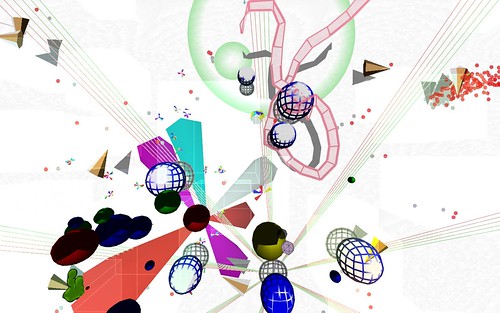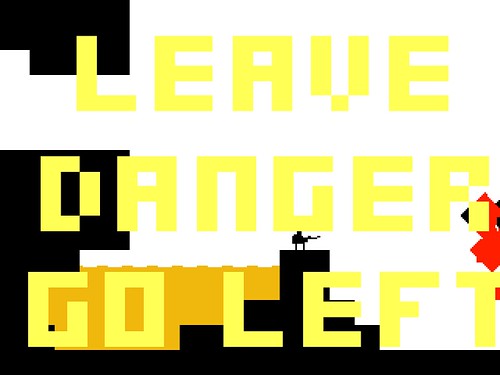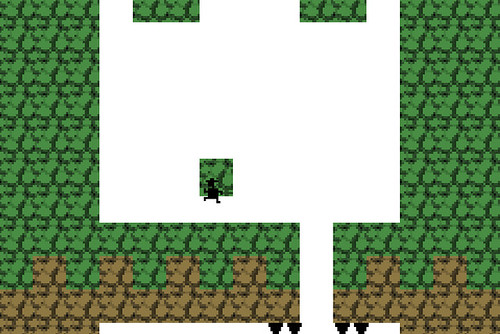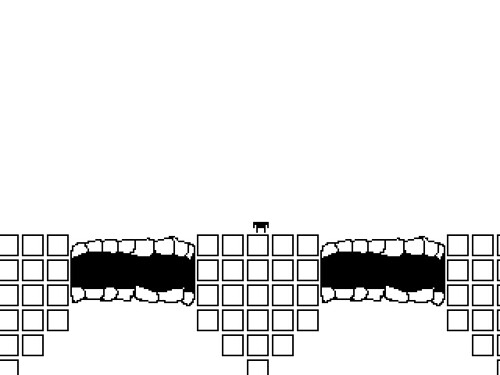Posts from ‘Abstract’ Category
Vertex Dispenser
By: Derek Yu
On: June 11th, 2011
Vertex Dispenser is a clever RTS where the goal is to overrun your opponents on abstract 3d worlds, claiming your territory vertex by vertex. The most interesting aspect of the game, in my opinion, is the resource management – resources come in seven different flavors, from blue, the least valuable, all the way up to white. The more nodes of a color you own, the faster that resource replenishes, but what color a node becomes when you tag it is dependent on the colors of the adjacent nodes. Specifically, it defaults to the lowest value color that is not present in the adjacent nodes. White, the most difficult color to obtain (because it requires that all six adjacent nodes are different colors), yields the most powerful abilities, and blue the weakest.
Getting the most out of the nodes requires some simple puzzle-solving, but it becomes much more difficult on a constantly changing battlefield where opponents are also expanding and poking at your defenses. It’s a cool idea, and despite the serenity of the abstract audiovisuals, Vertex Dispenser is pretty exciting to play at higher difficulties. The game comes with a single-player campaign, puzzle and battle modes, and the ability to play multiplayer games across platform (Windows/Macintosh).
The Polynomial
By: ithamore
On: December 18th, 2010
I first played Dmytry Lavrov’s The Polynomial (and enjoyed it for an hour or so) a year ago after it was posted as an earlier build on the Indiegames.com blog. Now I’ve rediscovered its latest rendition while I was searching for a new indie game to play, and I’m quite happy to be reacquainted with it and to experience all its new improvements. The video above explains most of the basics, so you could just watch it if you don’t feel like reading the rest of the review of this tripy, gorgeous game.
One Arm at a Time – An Octodad Interview
By: Alehkhs
On: December 5th, 2010
Octodad is a quick little game, full of charm, put together by a team from DePaul University. Taking control of an octopus attempting to keep his cephalopod nature a secret from his human wife and children, the player must perform a to-do list of chores around the house. Sounds easy enough, right? But then you get to the controls, which are a perfect balance between ‘impossible to use’ and ‘insanely fun,’ and you begin your day in the life of Octodad.
Having played the game myself, and having enjoyed it thoroughly. I sat down to talk with some members the team behind the project. The interview is after the jump, but if you’ve never played Octodad yourself, then check out the trailer and then go grab a download for yourself.
___________________________________________________
PAX 2010: Solace
By: Derek Yu
On: September 9th, 2010
[This is a guest review by NMcCoy. If you’d like to contribute an article for TIGSource, go here.]
So, I just got back from my day at PAX. There was all sorts of delightful stuff on display, fun things to do, and some very impressive demos in the expo hall. The one game that I was utterly blown away by, however, was not LittleBigPlanet 2 or Duke Nukem Forever or Final Fantasy XIV, but a student game in the PAX 10 called Solace. Something that’s been on my mind lately is the fact that while games, as a medium, have certainly been explored as a vessel for expressive artistic statement, gameplay has not often been a part of that. If you take Braid and remove the text, you end up with a puzzle game involving time manipulation that is barely about anything other than puzzles involving time manipulation. On the other hand, if you took Solace, removed the text, and replaced all the beautiful graphics and superb sound design with rectangles and beeps, it would still be about the five stages of grief as represented through the gameplay of its levels – the message would not be conveyed nearly so brilliantly, but nor would it be lost.
Ceramic Shooter – Electronic Poem
By: Paul Eres
On: April 13th, 2010
Ceramic Shooter – Electronic Poem by Theta games is a sequel to their earlier 2008 game Ceramic Shooter. Although it was released nearly a month ago, when I went to play it it had only been tried by 10 people. Ortoslon’s video playthrough of the game (above) had far more views as the game had plays; Death Worm had about 15000x as many plays. This was kind of surprising to me considering how good this game is.
I suggest neither watching the video or reading the rest of the review under the jump; just play it first. If you want instructions: avoid breaking stuff for the first half of the game (this is hard, because you can’t stop firing). After playing through it, then watch the video, because it shows some things that you probably missed while frantically trying to avoid shooting stuff. I watched the video first, which made me expect the game to be a lot easier than it actually is (it’s an Ortoslon video).
I found the design and music of this game top-notch; the sprites and graphics less so, but this is freeware. I especially liked how the music was in tune with the stuff that you have to avoid.
The concept for the game was also something I’ve been working on and thinking about for a while: an action game that isn’t about shooting everything, but still feels like an action game, with the same intensity. And this was achieved here, through a simple reversal: you have to move quick to avoid shooting things, because you can’t stop shooting. It’s certainly one way to do it. Maybe there are more.
There’s a trade-off in the game: if you stay near the bottom of the screen, you’re less likely to run into things and destroy them with your ship. But you then generate a long string of shots, which will destroy things more often. If you move to the top of the screen, you aren’t very likely to shoot anything at all (since your shots immediately go off screen), but you’re more likely to crash into things as they come into the view. How the player handle’s this trade-off is important; I usually kept myself in the middle of the screen.
The climax of the game comes about halfway in, when you’re finally able to shoot things (and encouraged to), although your real goal is to paint the screen full of color. That point is what makes it feel like a crime to me that this game had only 10 plays (hence this review). I hope to see a lot more from Theta Games.
Knot-Pharmacard Subcondition J
By: Guest Reviewer
On: March 31st, 2010
[This is a guest review by Stephen Lavelle. If you’re interested in writing an article for TIGSource, please go here.]
Knot-Pharmacard Subcondition J, by Michael Brough (epilepsy warning!).
I would recommend playing the game before reading on…
There is something very beautiful about the nature of the delicate and tentative interactions that can occur when encountering an unfamiliar system for the first time. Glum Buster is probably the canonical example for me. However, in this case the experience for me is one of interaction without surety of the nature of the effect – even after the fact: “I am doing something, but I am not sure what and I am not sure what effect it is having – nonetheless, it feels meaningful”.
Michael’s description, which I think deserves inclusion, reads:
The towlr games are not far removed from KPSJ experientially – they present situations with unknown mechanics – though I think they tend to be far more targeted at understanding (though I enjoy not understanding them as much as I enjoy understanding them). Pandora’s Gearbox comes to mind as well, though I think this is crucially different from all the other games mentioned because, in spite of hiding things, it allows for physical intuition, and relies on such reasoning.
One might say that KPSJ, Glum Buster, and the towlr games rely on a certain sort of ludic knowledge and intuition of their own, though I think the nature of this familiarity is very different to mechanical knowledge.
If one departs from systems that involve logical deduction, one can end up in a situation where exploration takes the form of an exhaustive search of a set range of interactions. This happened in GB sometimes, though I didn’t find it too much of an issue there. This happens when I play towlr games, though usually none of them work and it’s more a piece-of-mind exercise while I try to formulate other possible effective interactions and test the water. This doesn’t happen for me in KPSJ – I generally found myself overwhelmed by effect.
Some of Michael’s other games can be found here.
Captain Impostor
By: Derek Yu
On: March 3rd, 2010
Farbs just released the latest episode of his Captain Forever series, called Captain Impostor (available for all registered players). CI puts you at the helm of The Narcissus, a new type of ship that’s powered by a CLONE DRIVE. The CLONE DRIVE lets you steal entire ships and make them your own. However, the strength of the parts cloned depends on how much clone power you have. Destroy other ships to raise your clone power!
So far I’m enjoying the cloning mechanic, but the lack of construction makes it a little less interesting than Successor, in my opinion. I’m still waiting for a more cohesive world and story, but I don’t know if that’s in the cards or not. In any case, it’s fun to see the series evolve and try new things.
Developer Highlight: Connor Kimbrough
By: fuzz
On: January 26th, 2010
Connor Kimbrough, more commonly known as Beef or Professor Dead, is a quirky and little known game developer. A member of The Poppenkast, his games often consist of innovative or strange gameplay ideas coupled with silhouette-based, stylistic graphics. He describes himself as “a cute man with ten fingers, ten toes. lives in tulsa, oklahoma. he once had to have 5 shots for rabies.” I’d like to highlight a few of his games here so that a few more people will be able to enjoy them.
All of Connor’s games use a Z+X+ENTER control scheme unless otherwise specified within the game.
Botulism, named after a disease causing paralysis through the infection of a wound, is a platformer that is frustrating not so much in being technically difficult, but in its refusal to allow for human error. They player acts as a man with a machine gun, jumping on a series of platforms to reach the end of each level. On the way he encounters many running figures, who can easily be shot, but do not fight back. The background music is a dissonant drone, reinforcing the image of a cold, calculating killer. The gameplay is essential to the theme; the hero is a robot, an unemotional being of rationality who kills because he must. Therefore, the main character’s deaths must be the result of the player not being robotic enough, not carefully examining the data before them and moving based on prior experience. Through seven levels and a number of hidden counterparts to these levels, the man with the machine gun jumps through a world of silhouettes and toxicity, culminating in an enemy too strong to defeat and thus a fearful thing to run from. You become the runners that you have shot, and the post-game stats screen displays only one attribute of the playthrough: the number of deaths that you have caused.
More games after the jump:
In Hot Ninja Moon Moon, you play as a ninja slaughtering the enemies of the Motherland and preventing a peasant revolt. What makes this game stand out is its method of portraying player deaths; upon reset, all dead bodies from the player’s losses remain. The graphics are decent, although nowhere near as good as in some of Beef’s other games. The design works, but there are far too many spikes and not enough of anything else. The sound design is minimalist and atmospheric, making the frustrating portions bearable. Overall, a somewhat average platformer, with a graphical display of death similar to that in Jesse Venbrux’s Deaths. Connor is currently working on an update to this game, entitled “Hot Ninja Moon Black”, which looks like it will be a great improvement on the original.
Blazing Sadholes was made for The Poppenkast’s 2 hour “Western” competition. Unabashedly inspired by The Mighty Jill Off, Sadholes features Beef’s distinctive silhouette pixel art and a great deal of difficult, spike-laden platforming. The succinct story is communicated primarily through gameplay, although there is a short cutscene at the beginning showing the cowboy falling into a pit, horse and all. Having lost his hat, his horse, and his way, he does his best to retrieve his possessions and find his way out. The discovery of these items along the way carries the story effectively in a way that doesn’t require words; Beef tends to tell wordless stories quite well in his games and this is no exception. The game never finishes; there is a point where you can progress no further, but this is really a non-ending. The cowboy becomes stuck indefinitely in the pit and the final jump is too high for him. Likely a case of laziness, this design decision is fairly unimportant to the game. Sadholes suffers from unevenly spaced platforms, resulting in the player being forced to wait for the cowboy, who often jumps too high, to return to the ground. A well done little distraction, but there’s not much more to this one.
TimmyTimmyTimmy is a short form experimental platformer. In other words, it’s a game where you walk from one side of the screen to the other without anything notable happening. Still, it’s interesting to try to comprehend whatever obscure meaning it’s intended to have, and the art style is fairly unique. Three sentences are all that’s required to describe the entire experience:
“MONDAY” reads the game, with yellow text on a black screen. A formless white silhouette, controlled by the player, chases a black silhouette over a cliff made up of a patchwork of textures. “TUESDAY” says Timmy, and the game is over.
Saqrifize utilizes a unique gameplay mechanic, involving switching between two parallel planes that have a direct influence over each other. The two planes are viewed by either jumping or standing. Some obstacles will only appear in one plane rather than the other, so this creates some interesting challenges, although unfortunately the concept is explored very little. The graphics are again in Beef’s characteristic silhouette style. The story is vague, something about Hannibal Lecter and souls being stolen, but the real point of the game is its fascinating plane-switching mechanic.
Doom Mantra is a platform shooter entered into The Poppenkast’s No Words competition. Strange and compelling, the game utilizes its graphics as the sole means of communication with the player. A three colour scheme for the graphics ensures the clarity and precision of the art, so that a vague story is fairly easily understood even as you are bombarded with enemies.
Sad Torino Girly Harry is a collaboration between Beef and a fellow Poppenkast member, Cow. A cosmonaut’s adventure in an alien land, STGH does a great job of emulating the strangeness of an unknown planet via objects that act in ways that they aren’t expected to. Fire rotates your position on the screen rather than hurting you, eggs are teleporters, and leaving the first screen changes the cosmonaut into a pink man with a watering can. These inversions of traditional game values, as well as several others within the game, add to the general oddity of the experience. Extremely short, but a novel adventure into the mind of a lunatic.
Fuck Punishment is a tribute to Messhof‘s Punishment. Basically it’s just a two player version of Punishment, although with more of a focus on horizontal than vertical platforming. Fun for a couple of minutes, but it stops being interesting quickly as it can’t match Punishment and doesn’t introduce many original ideas of its own.
European Hand Love With Boy and its sequel were entered into increpare’s informal Love Letter contest a while back. The essential storyline is that the character’s hand has AIDS and must be saved so that he can masturbate once more. Elegant, minimalist graphics mixed with scrawled penises make for an interesting mix, and the music is really catchy and aurally interesting. The main issue with the game is that the player is forced to restart upon death, making for a limited desire to continue play until the ending.
Eufloria – Released!
By: Xander
On: October 23rd, 2009
“It’s bloomin’ great!” – Xander
Sorry for that. Anyway as you should be aware Eufloria, previously ‘Dyson’, has been released on Steam, D2D and through the official site. If you didn’t know this then I’m afraid you’re simply not cool. However in reading this post you now DO know this, and have automatically been saved from an awkward moment of self-doubt and an accusing glare. It’s fine, no need to thank us, we’re just doing our job. If you really do want to show your gratitude then why not pick your favourite digital distributor and play one of the most elegant strategy titles of recent memory.
If you’re still on the edge, you can also play the demo to find out if nothing else just why we needed to tell you that you could.
TIGdb: Entry for Eufloria
Stimergy
By: Brandon McCartin (BMcC)
On: August 17th, 2009
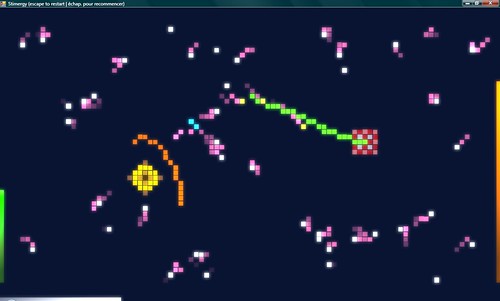
I should have seen this on either Heather or Renaud‘s blog, but of course I saw it on ’ll never get away with this, Offworld!">Offworld.
Stimergy is a game by Kokoromi‘s Heather Kelley and ’s Site">Polytron’s Renaud Bédard (Team EMERGENCY HAMMER), created in under 36 hours for the Bivouac Urbain game jam in Quebec. In the game you must guide ants toward a picnic blanket using attractive and repulsive pheromones. According to Renaud:
"The game was made from scratch in C# 3.0 using the Truevision3D engine with no prior design, graphics or sound work. All the graphics in the game are procedural, and the gameplay itself is based on AI rules, basically a cellular automaton plus the notion of “stigmergy†from the insect world."
You can find Stimergy here, along with a postmortem and time-lapse video of the creation of the game. And on the forums Renaud was kind enough to post a link to the rest of the Bivouac Urbain games, which includes entries by Anna and Messhof, among others. Pictures of the event can be found here.
